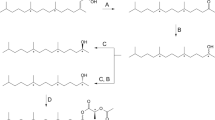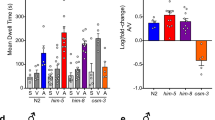Abstract
SINCE the isolation of the first insect sex pheromone, bombykol, from the female silkmoth Bombyx mori1 and its full identification by synthesis as (10E, 12Z)-10,12-hexadecadienol2,3, the number of characterised pheromones has increased dramatically4–7. The basic question of pheromone–receptor interactions remain unanswered, however. To devise a method which could be used to study such problems, it was necessary to modify the natural pheromone in such a way as to specifically label the binding site of its chemoreceptor cell. We chose to convert the acetate group, a common feature in Lepidoteran pheromones4–7, into a diazoacetate derivative. Information about the active site of the pheromone receptor cell can then be obtained by reacting it irreversibly with a carbene derived from the diazoacetate group. In this procedure, the modified pheromone is radioactively labelled, and since the carbene is generated photolytically, the process is called photoaffinity labelling8,9. We have used electrophysiological techniques as a very sensitive and rapid bioassay method to check the activity of the modified pheromone. We recorded the responses from single receptor cells and evaluated the changes in receptor potential and nerve impulses activity accompanying exposure of the antennae to a stream of pheromone10–12. We describe here experiments showing that the diazoacetyl derivative of the pheromone acetate (VII) meets the requirements of a photoaffinity label for the study of the receptor.
This is a preview of subscription content, access via your institution
Access options
Subscribe to this journal
Receive 51 print issues and online access
$199.00 per year
only $3.90 per issue
Buy this article
- Purchase on Springer Link
- Instant access to full article PDF
Prices may be subject to local taxes which are calculated during checkout
Similar content being viewed by others
References
Butenandt, A., Beckman, R., Stamm, D. & Hecker, E. Z. Naturforsch. 14b, 283–284 (1959).
Butenandt, A., Hecker, E., Hopp, M. & Koch, W. Justus Liebigs Ann. Chem. 658, 39–64 (1962).
Truscheit, E. & Eiter, K. Justus Liebigs Ann. Chem. 658, 65–90 (1962).
Jacobson, M. Insect Sex Pheromones (Academic, New York, 1972).
Evans, D. A. & Green, C. L. Chem. Soc. Rev. 2, 75–97 (1973).
Jacobson, M. in The Physiology of Insecta 3 2nd ed. (ed. Rockstein, M.) 229–276 (Academic, New York, 1974).
Shorey, H. H. & McKelvey, J. J., Jr (eds) Chemical Control of Insect Behavior: Theory and Application (Wiley, New York, 1977).
Singh, A., Thornton, E. R. & Westheimer, F. H. J. biol. Chem. 246, 3928–3933 (1971).
Knowles, J. R. Acc. Chem. Res. 5, 155–160 (1972).
Boeckh, J. Z. Vergl. Physiol. 46, 212–248 (1962).
Kaissling, K.-E. in Handbook of Sensory Physiology 4 (1) (ed. Beidler, L. M.) 351–423 (Springer, Berlin, 1971).
Kaissling, K.-E. in Biochemistry of Sensory Functions (ed. Jaenicke, L.) 243–270 (Springer, Berlin, 1974).
Kochansky, J. et al. J. Insect Physiol. 21, 1977–1983 (1975).
Corey, E. J. & Suggs, J. W. Tetrahedron Lett. 2647–2650 (1975).
Pettei, M. J., Pilkiewicz, F. G. & Nakanishi, K. Tetrahedron Lett. 2083–2086 (1977).
Doering, W. von E. & Knox, L. H. J. Am. chem. Soc. 78, 4947–4948 (1956).
Chaimovich, H., Vaughan, R. J. & Westheimer, F. H. J. Am. chem. Soc. 90, 4088–4093 (1968).
Roelofs, W. L., Hill, A. S. & Carde, K. T. J. chem. Ecol. 1, 83–89 (1975).
Klun, J. A. et al. Science 181, 661–663 (1973).
Weygand, F., Bestmann, H. J. Angew. Chem. 72, 535–554 (1960).
Strausz, O. P., DoMinh, T. & Gunnigan, H. E. J. Am. chem. Soc. 90, 1660–1661 (1968).
Author information
Authors and Affiliations
Rights and permissions
About this article
Cite this article
GANJIAN, I., PETTEI, M., NAKANISHI, K. et al. A photoaffinity-labelled insect sex pheromone for the moth Antheraea polyphemus. Nature 271, 157–158 (1978). https://doi.org/10.1038/271157a0
Received:
Accepted:
Issue Date:
DOI: https://doi.org/10.1038/271157a0
This article is cited by
-
Perfluorinated moth pheromones
Journal of Chemical Ecology (1990)
-
Haloacetate analogs of pheromones: Effects on catabolism and electrophysiology inPlutella xylostella
Journal of Chemical Ecology (1988)
-
Binding and hydrolysis of radiolabeled pheromone and several analogs by male-specific antennal proteins of the mothAntheraea polyphemus
Journal of Chemical Ecology (1986)
Comments
By submitting a comment you agree to abide by our Terms and Community Guidelines. If you find something abusive or that does not comply with our terms or guidelines please flag it as inappropriate.



